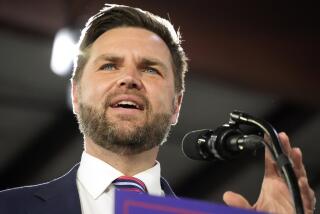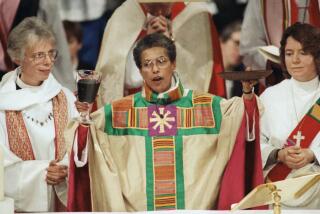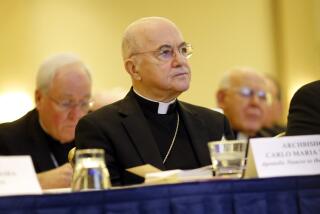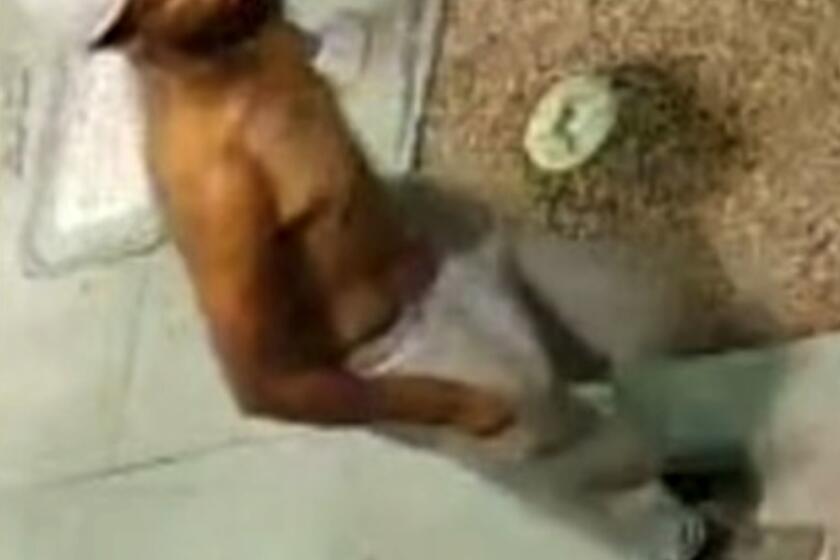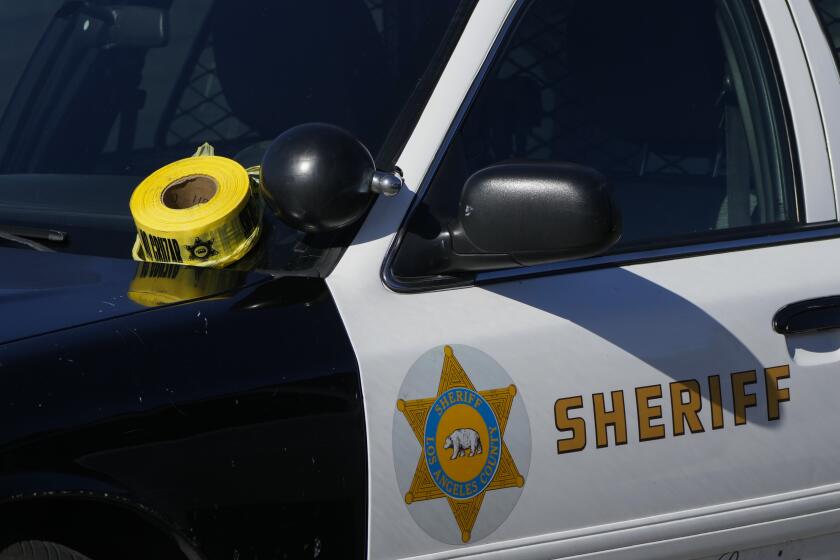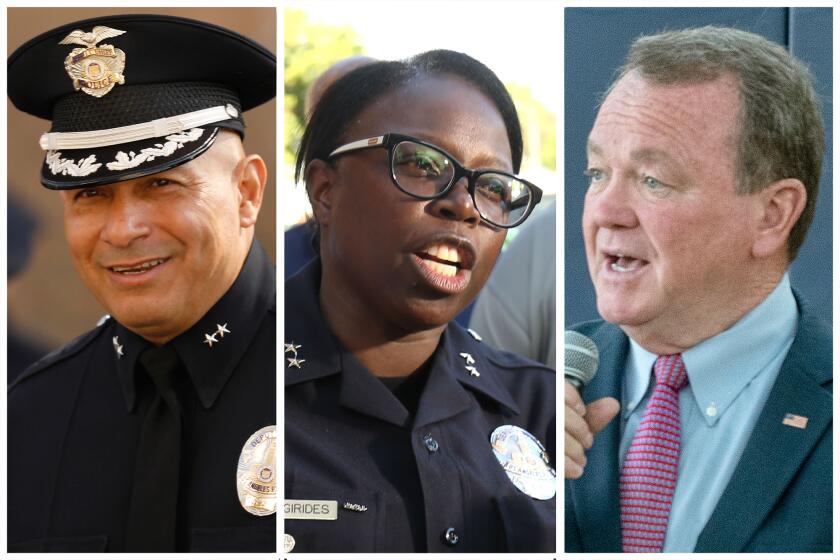Conservative Trend Found in Younger Priests
Pope John Paul II, whose 15-year reign over the Roman Catholic Church has been marked by repeated efforts to restore orthodoxy, may now be succeeding in attracting a new crop of more conservative priests to carry the church into the next millennium.
Although it is too early to say whether there is a sustained drift toward orthodoxy, younger priests are clearly more religiously orthodox and politically conservative than middle-aged priests, according to a nationwide poll of priests by The Times.
Ordained during the pontificate of John Paul, they are less supportive of ordaining women and allowing priests to marry than are middle-aged priests, and they are less tolerant of married couples using artificial birth control or surrogate birth mothers to bring a child to term.
On other moral issues, such as euthanasia, abortion or sexual relations outside of marriage, both younger and middle-aged priests tend to be orthodox in their thinking. Only the oldest priests are more conservative.
In the political arena, nearly 40% of priests 35 and younger consider themselves conservative--almost double the percentage between the ages of 36 and 50. Moreover, the youngest priests are twice as likely to identify with the Republican Party (35%) than are priests in general (16%).
The findings from the poll of 2,087 Roman Catholic priests and 1,049 Roman Catholic nuns appear to validate results in recent church-sponsored polls that point to greater conservatism among new priests.
“The pattern is there in dozens of questions on the poll indicating that the traditional character of the 15-year pontificate of John Paul II is clearly affecting the selection, or self-selection process, for new candidates for ordination,” Times Poll Director John Brennan said.
The findings are among a wealth of information on how priests and nuns view their church--its strengths, its problems and its future.
Overall, significant majorities of priests and nuns are happy in their calling, would take their vows again if they had a choice and think well of John Paul’s job performance.
“Honest to God,” wrote a self-described liberal 61-year-old priest from the Northeast, “I am still extremely excited about the gift of faith, the life it gives and sustains, the peace beyond all telling (beyond Rome). What a comfort. I’m proud to share.”
But even though the vast majority of priests appear to be happy with their lives, they are less sanguine about the institutional church in the United States.
Fifty-three percent of all priests believe it is weaker than it was 30 years ago; 29% say it is stronger. Another 10% say the strength of the church is about the same.
A bare majority of priests--54%--call things in the church excellent or good, whereas 43% say they’re not so good or poor. Nuns are more pessimistic still, with 51% assessing things as not so good or poor, compared to 44% who believe things are good or excellent.
Priests are fairly evenly divided between those who say things are getting better (31%) and worse (33%), with 25% saying things are about the same.
When asked what the greater danger for the church is these days, 42% said it was the excessive desire to please secular and humanistic forces in society; 28% said it was resistance to reform of moral doctrines.
The poll found that a disproportionate number of priests (95%) are white at a time when the ethnic diversity of the church in the United States is demanding new approaches to ministry. However, 24% of all priests now speak Spanish, with more than two of five priests 35 or younger speaking that language.
Although the number of Catholics continues to grow, priests and nuns say when people leave the church they do so because of both shortcomings by the institutional church, the influence of materialism and secular culture, and a lack of faith and commitment by individuals.
But perhaps the most intriguing finding has to do with a possible drift toward orthodoxy by the newest and youngest of priests.
They are more conservative as a group than are middle-aged priests, who were ordained and matured in the priesthood during the 1960s, when the Second Vatican Council ushered in an era of renewal and reform within the church.
By contrast, the new priests were trained during a time when John Paul has steadfastly championed a return to orthodoxy, emphasized that the church’s moral teachings are unchangeable, elevated conservative priests to the episcopacy, and made clear his unflinching opposition to artificial birth control, women priests, married priests, “cafeteria Catholicism” and dissenting theologians.
Only about 20% of all priests between the ages of 36 and 60 describe themselves as religiously conservative, but 32% of the youngest priests do so. Only priests older than 70 are more conservative as a group, the poll found. In the oldest group, 49% call themselves religious conservatives.
Experts within the church disagree whether the more conservative complexion of the youngest group of priests constitutes a trend toward an orthodox restoration.
“I would be wary about saying you have a trend here,” said the Rev. Andrew W. Greeley, a Catholic sociologist, author and associate at the National Opinion Research Center in Chicago.
But church sociologist Dean Hoge of Catholic University of America in Washington said that The Times’ findings replicate those in separate church-sponsored polls. Hoge said there is “a very definite trend” toward conservatism by younger priests--at least on issues involving the priesthood, if not always on moral issues.
Given John Paul’s appointment of conservative bishops and other efforts to restore orthodoxy, the growing number of conservatives among new priests isn’t surprising, said Richard A. Schoenherr, a sociology of religion professor at the University of Wisconsin and author of “Full Pews, Empty Altars.”
“It’s something that was predictable with regard to the kind of church the current Pope is trying to construct,” Schoenherr said in an interview.
But he and Brennan noted that the youngest priests account for just 6% of the total priest population in the United States. And despite the greater percentage of conservatives within their group, most young priests still consider themselves moderates or liberals.
“The evolution toward orthodoxy and the Republican Party will no doubt take some time,” Brennan said.
Nonetheless, the signs of increased conservatism among the current group of new, young priests is unmistakable.
On a raft of issues, the youngest priests are more closely aligned with the Pope and the most orthodox members of the hierarchy. These priests are more likely to approve of how John Paul has handled his duties as Supreme Pontiff, and say that the Pope’s views on moral issues are “about right.”
They are also more apt to oppose a declaration of rights for dissenting Catholic theologians.
Last August, for example, in a landmark encyclical letter to the world’s bishops, the Pope said that if Catholic theologians fail to be faithful to church teachings they should be stripped of the title “Catholic” and barred from teaching at Catholic institutions.
A 29-year-old priest from the Midwest who described himself as a religious conservative agrees with the papal directive. “There exists in the Roman Catholic Church too much pick-and-choose Catholicism,” he wrote on his questionnaire. “To be considered Catholic, one must accept all that the church teaches.”
Considering John Paul’s uncompromising belief that artificial birth control is morally evil, he would not likely be pleased that only 48% of the youngest priests say that it is always or often sinful. But there is even less support from middle-aged priests--36% of those between ages 36 and 50, and 37% among those 51 to 60.
The church condemns homosexual acts and not homosexuality per se, so the ordination of celibate homosexuals is not strictly forbidden. But support for such ordinations varies among priests, with 53% in support and 41% in opposition. The youngest and middle aged priests were more enthusiastic. Sixty-eight percent of those 35 or younger favor ordaining celibate homosexual men, and 69% of those age 35 to 50 are in favor. Priests over 70 oppose the idea 61% to 30%.
Despite the fact that higher percentages of younger priests are conservative, an orthodox restoration won’t come overnight.
Brennan noted that those between ages 36 and 60 account for almost half the priest population. And despite their Republican drift, most of the younger priests are still Democrats (32%) or independents (29%).
It is unclear why higher numbers of the new priests are more religiously orthodox and politically conservative.
Authorities within the church suggest several reasons. The first is self-selection. “It’s not that seminary training has been changed. It’s who self-selected themselves to enter seminary,” said Hoge at Catholic University of America.
Another factor may be that the youngest priests grew up in the Reagan-Bush era. Greeley called it the “period effect.”
“The people that were ordained in the ‘60s grew up in the ‘60s, which was a radical era,” he said. “The people who are being ordained now grew up in a more conservative era.”
Regardless of age or religious ideology, by far the biggest problem listed by priests is the shortage of priests. Nearly 60% of all priests favored the idea of allowing married priests.
“The church will continue to languish as long as we maintain that only celibates may serve in the priesthood,” said a 57-year-old priest in the South. “The laity want service and holy priests and could care less about marital status.”
There are any number of other explanations for the shortfall in vocations. Some believe the scandal of child sexual abuse has taken a toll.
“The message I get in general is this thing about sexual abuse by clergy has been a real downer for the priesthood,” said Hoge. “It has been absolutely the worst thing that’s happened. The people around here just wish to God it hadn’t happened. It’s taking a toll on everybody, taking a toll on finances, and on people entering the priesthood.”
Although U.S. bishops continue to put new safeguards in place, support groups for clergy sexual abuse victims say the church has not done enough.
Less than half (41%) of the priests surveyed said they considered pedophilia within the priesthood as a “very serious” problem. Another 31% called it somewhat serious, and 18% called it not too serious or not at all serious.
Many priests in written explanations, however, stressed that they were unsure how to respond, saying that even one case would be very serious but that they did not want to indicate the problem was widespread.
Brennan said the question was phrased as it was not to measure the potential amount of child sexual abuse but the intensity of priests’ attitudes about the issue.
“Obviously, one case of clergy pedophilia is serious--very serious,” said a 66-year-old priest in the Midwest. “But if you speak of the number of cases or actual clerical offenders it is a very small percentage, much smaller than that of other professional people.”
Told of the explanation, Greeley, who has severely criticized the church for its slow response in the past, said he was astounded. “They don’t think it’s a serious problem! But it is an enormous problem!”
Jason Berry, the author of a book on the problem, has estimated that between 1984 and 1992, more than 400 Catholic priests in North America were reported to have molested children. As of that time, he estimated, the church had paid out $400 million to resolve the cases.
How the Poll Was Conducted
This Times Poll is based on interviews with 2,087 Roman Catholic priests and 1,049 Roman Catholic nuns in dioceses across the United States, including Puerto Rico. The survey was conducted by mail from September, 1993, through this past January. It represents responses to a mailing of 5,000 questionnaires to priests in 80 dioceses and 2,500 to nuns in 45 dioceses. The samples of dioceses were chosen from a list that gives the total number of priests and nuns in all dioceses nationwide. Respondents within targeted dioceses were then chosen randomly from available lists. The questionnaires, in English and Spanish, were self-administered and anonymous, though some respondents volunteered to be interviewed and quoted by name. Both samples were weighted slightly to account for variations in the number of responses received from each diocese.
The demographics of both surveys have been examined by academic experts in the field of priests and nuns sociology and have been found comparable to previous research in this area. The margin of sampling error for the survey of priests is plus or minus 3 percentage points; for the survey of nuns it is plus or minus 4 points. In both polls, results based on subgroups may have a somewhat higher sampling error. Poll results can also be affected by other factors such as wording of questions and the reluctance of some respondents to participate in surveys.Conservative Trend Found in Younger Priests
More to Read
Sign up for Essential California
The most important California stories and recommendations in your inbox every morning.
You may occasionally receive promotional content from the Los Angeles Times.
